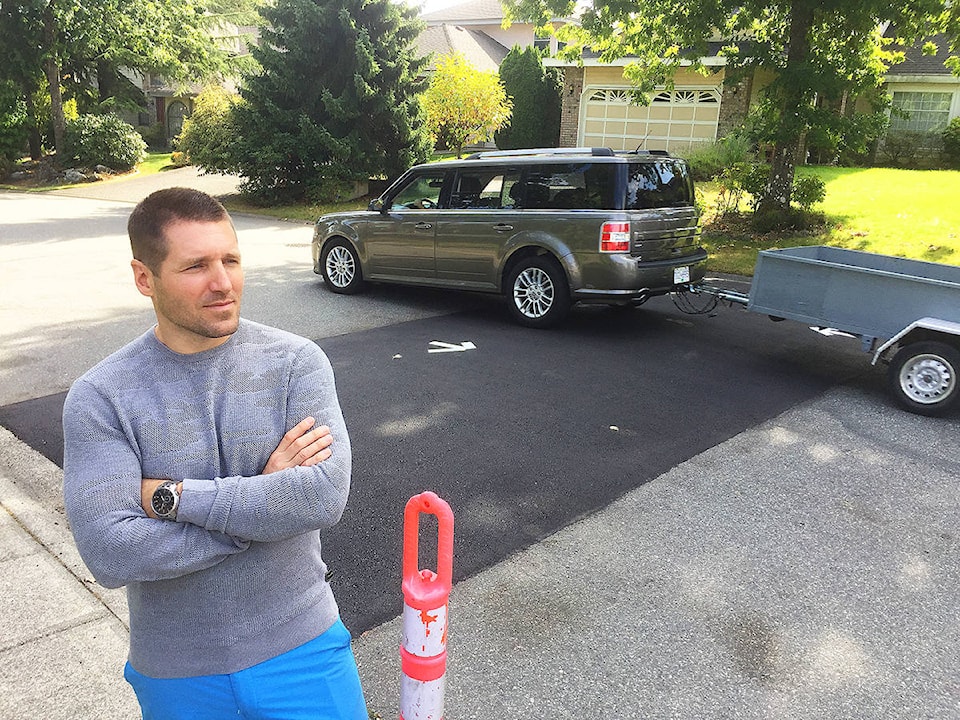For James Perry, April 3 of 2015 wasn’t such a Good Friday.
That morning, the Fraser Heights resident’s son, Cole, and his pals were playing street hockey outside his home when a car came speeding around a bend in the road, Glenwood Crescent East.
“The kids knew to yell ‘Car!’ when one came toward them, but she came in really fast,” Perry said of the driver.
“Cole was one of the kids closest to (the vehicle), and he was looking for the hockey ball that had gone under my vehicle parked on the side of the road. As he stood up, he saw her coming at him and tried to run around the truck and jump to the sidewalk.”
The vehicle’s mirror struck Cole in the side, knocking him to the ground. The boy, who was 10 at the time, was pulled under the tires and dragged for about 10 feet.
Cole ended up with two broken bones in his right leg, and a nasty gash from his heel right up the side of his leg, where he had to have some partial skin grafting.
“He has some pretty heavy-duty scars,” Perry said. “He had to have metal plates and screws inserted into all the bones, and he had to have a few surgeries to get him out of that situation.”
Almost immediately, Perry went to work to somehow make drivers slow down on the particularly speedy section of road, which has a history of car accidents involving pedestrians. At least one was fatal, about 20 years ago, according to Perry.
Finally, last month, more than two years after Cole was injured, three paved speed humps have been installed on the street – but Perry isn’t entirely satisfied with the speed-reduction measure.
“In my mind, this is better than nothing,” he said, “because you can see cars slowing down a bit more now, but I really do think the city should put up street signage – very visible signs calling for slower traffic. Put up some 30s on the corners, down from 50 (kilometres an hour).
“There are sharp, blind corners, and a lot of kids around here.”
In his lengthy fight for a traffic-calming solution on the relatively wide street, located in the heart of Fraser Heights, Perry was surprised by the amount of resistance he encountered from Surrey city hall.
“They kept saying, ‘no, no, no,’ even with major accidents right here, on the corners, down the street,” Perry said. “The neighbours here have petitioned about the safety here as early as 2002, and we have those letters to the city.… People here want cars to slow down.”
The city’s criteria for installing traffic-calming measures involves calculating the number of vehicles on a certain roadway, and how fast they typically travel.
“We kept getting told, ‘Sorry, you have not reached the criteria for calming in your area,’ but the way they calculate things is dumb,” Perry said. “We didn’t hit their exact criteria, but for the residents here, 50 per cent of (vehicles) doing nine over the speed limit is a hell of a lot more dangerous than 15 per cent of them doing 10 over. They just don’t look at it in a very logical way.
“It needs a revamp, another look at it.”
The City of Surrey says it has constructed about 250 traffic projects since 2005.
Surrey’s transportation manager Jaime Boan said the city uses the “85th percentile” as the threshold for traffic calming and said it didn’t apply in this case.
Boan said this is an “internationally accepted figure used in transportation engineering as representative of the reasonable and responsible majority of motorists.”
“Traffic calming is only effective at reducing speeds where the majority of traffic is driving at higher speeds,” Boan added. “It isn’t effective where only a few motorists are driving inappropriate so it makes sense to use the speed of the majority of the traffic as the criterion.
“Where we have installed traffic calming on local roads, we have successfully reduced the 85th percentile speed down to about 50 km/h. (50 km/h midway between speed humps; about 30-35 km/h at the humps.)”
While Perry calls for a speed limit reduction to 30 km/h on Glenwood Crescent, Boan said the curves are not sharp enough to warrant it.
Though Boan did say, once the humps have been in place a few months, the city will follow-up to confirm if the humps are effectively reducing speeds.
As for Cole, he has returned to play hockey in Cloverdale, with his dad coaching. That spring he was hit by a car, he ended up in a wheelchair, watching everyone else play a game he loves.
“He was a trooper and worked really hard through the summer, was in physiotherapy and in conditioning camps to get himself into a position to play high-level hockey again,” James said.
“I’m proud of him.”
tom.zillich@surreynowleader.com
Like us on Facebook and follow Tom on Twitter
